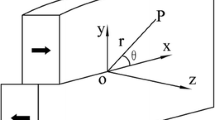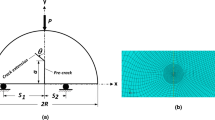Abstract
An experimental study was undertaken concerning the propagation of a slant crack under compression. By using the equations of the deformed shape of a crack and by introducing a correction model in order to prevent the crack lips from incompatible displacements, an estimate of the stress distribution along the crack borders was achieved. It was found that an opening-mode K 1 stress intensity factor (SIF) must be introduced at the crack tips in the overall compressive stress field, in order to give the required space for the lip-slip phenomenon, due to shearing, to take place. This local dilatation in the vicinity of the crack tip, together with the lip-slip phenomenon, due to which the initial crack tip is displaced into a new position along the deformed crack borders, causes the out-of-plane propagation of the crack, either towards the largest compressive stress in the case of biaxial stress field, or towards the applied compression in a uniaxial compressive field. A series of experiments on PMMA (perspex) rectangular specimens with pre-existed cracks and slits has been executed and the type of the stress field in the front of the propagated branches is examined by using the method of caustics. It was found that the crack propagation under compression is an interactive process of two conjugate branches, which is strongly influenced by the boundary conditions of the pre-existed discontinuity.
Similar content being viewed by others
References
E. G. Bombolakis, Tectonophysics 1 (1964) 343.
E. Hoek, “Rock fracture under static conditions”, National Mechanical Engineering Research Institute, C.S.I.R., Pretoria, Report MEG 383 (1965).
E. Hoek and Z. T. Bieniawski, Int. J. Fract. Mech. 1 (1965) 137.
G. P. Cherepanov, PMM 30 (1966) 82.
Z. T. Bieniawski, Int. J. Rock Mech. Min. Sci. 4 (1967) 395.
W. F. Brace and E. G. Bombolakis, J. Geophys. Res. 68 (1963) 3709.
S. A. F. Murrell, Br. J. Appl. Phys. 15 (1964) 1195.
B. Cotterell, Int. J. Fract. Mech. 8 (1972) 195.
F. Erdogan, “Continuum Mechanic Aspects of Geodynamic and Rock Fracture Mechanics”, Proc., NATO Advance Study Inst. edited by P. Thof-Christensen (D. Reidel Publications, Holland, 1974) p. 45.
S. Nemat-Nasser and H. Horii, Int. J. Engng Sci. 22 (1984) 999.
A. R. Ingraffea, in “Fracture Mechanics of Rock”, edited by B. K. Atkinson (Academic Press, London, 1987) p. 71.
V. Li, ibid. p. 351.
S. L. Crouch, “Analysis of Stresses and Displacements around Underground Excavations: An Application of the Displacement Discontinuity Method”, Geomechanics report to the National Science Foundation, University of Minnesota, USA (1976).
P. S. Theocaris, D. Pazis and B. Konstantellos, Int. J. Fracture 30 (1986) 135.
P. S. Theocaris, Engng Fract. Mech. 26 (1986) 753.
Idem., Appl. Optics 10 (1971) 2240.
Idem., in “Developments in Stress Analysis” I, edited by G. S. Holister (Applied Science Publishers, London, 1979).
Idem., in “Mechanics of Fracture” Vol. 7, edited by G. C. Sih Nijhoff Publications, The Hague, 1981) Ch. 3, p. 189.
N. I. Muskhelishvili, “Some Basic Problems of the Mathematical Theory of Elasticity” (Noordhoff International, Leyden, 1975).
P. C. Paris and G. C. Sih, in “Fracture Toughness Testing and its Applications”, ASTM, STP 381 (1969) p. 30.
A. E. Green and W. Zerna, “Theoretical Elasticity” (Oxford University Press, London, 1968).
G. C. Sih, in “Methods of Analysis and Solutions of Crack Problems” edited by G. C. Sih (Noordhoff International, Leyden, 1973) p. 21.
P. S. Theocaris and D. Pazis, Appl. Optics 20 (1981) 4009.
Author information
Authors and Affiliations
Rights and permissions
About this article
Cite this article
Theocaris, P.S., Sakellariou, M. Crack propagation in brittle materials under compressive stresses studied by caustics. J Mater Sci 26, 1640–1646 (1991). https://doi.org/10.1007/BF00544676
Received:
Accepted:
Published:
Issue Date:
DOI: https://doi.org/10.1007/BF00544676




